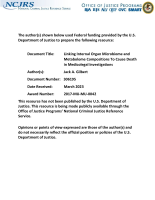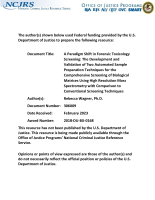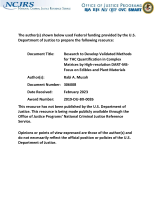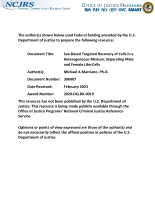Research and development
Research on Forensic Toxicological Laboratory Testing and Reporting Practices
NIJ FY23 Research and Evaluation on Policing Practices, Accountability Mechanisms, and Alternatives
NIJ FY23 Criminal Justice Technology Testing and Evaluation Center
NIJ FY23 Youth Mentoring Research and Evaluation
NIJ FY23 Research on Juvenile Justice Topics
Measuring the Impact of Victim Services
NIJ FY 2023 Research and Evaluation on Jails Solicitation Webinar
,
A Leg Up: NIJ's Graduate Research Fellowship Program
A Leg Up: NIJ's Graduate Research Fellowship Program
NIJ Director Dr. Nancy La Vigne joins the show to interview Dr. Marie Garcia, Director of NIJ’s Criminal Justice Systems Division and a former NIJ graduate research fellow. They discuss the application process, Marie’s experience as a fellow while at Temple University, and advice for future applicants.
Reading and Resources from NIJ:
Inclusive Research: Engaging with the People Closest to the Issue
See the YouTube Terms of Service and Google Privacy Policy
Assessing Risk of Terrorist Acts by Looking at Location Data and Demographic and Social Characteristics
NIJ FY23 Community-Based Violence Intervention and Prevention Initiative (CVIPI) Research, Evaluation, and Associated Training & Technical Assistance Support
A Paradigm Shift in Forensic Toxicology Screening: The Development and Validation of Two Automated Sample Preparation Techniques for the Comprehensive Screening of Biological Matrices Using High Resolution Mass Spectrometry with Comparison to Conventional Screening Techniques
Research to Develop Validated Methods for THC Quantification in Complex Matrices by High-resolution DART-MS-Focus on Edibles and Plant Materials
Sex-Based Targeted Recovery of Cells in a Heterogeneous Mixture: Separating Male and Female Like-Cells
Enabling the Enablers: An Identity Fraud Solution for Law Enforcement
Assessing Risk of Terrorist Acts by Looking at Location Data and Demographic and Social Characteristics
A new NIJ-supported study combines two existing analytical tools—risk terrain modeling and conjunctive analysis—to link location and risk of terrorism. This approach identifies areas of high risk, providing opportunities for more effective interventions.
ICA Color Space for Pattern Recognition
The Bayes Decision Rule Induced Similarity Measures
Director La Vigne Discusses Forensic Research and Development at NIJ
NIJ Director Nancy La Vigne, Ph.D., was interviewed by the American Academy of Forensic Sciences.
Utilizing the "listen, learn, and inform" model is what Nancy La Vigne, the new Director at the National Institute of Justice says will be key in implementing the Forensic Science Strategic Plan. AAFS-TV sits down with La Vigne, fresh in her new role, to discuss how she plans to help researchers and scientists achieve their goals.
See the YouTube Terms of Service and Google Privacy Policy








